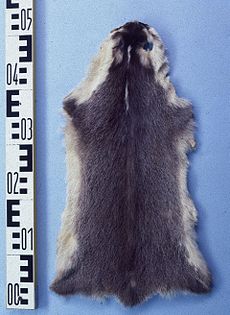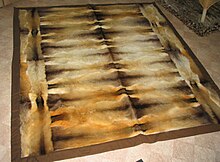Pahmi
- Pahmi skins
Pahmi is the trade name for the skin of the sun badger , usually only the skin of the Chinese sun badger is traded .
There are four to five types of sun canopy, see the main article sun canopy . Their distribution area extends from eastern India and central China over the Malay Peninsula to Borneo and Bali.
The pahmis or sun badgers are slimmer than the badger, more like the marten. The legs are relatively short. The animals reach a head body length of 33 to 43 centimeters, in addition there is the bushy tail with 15 to 23 centimeters. A special feature is the badger- like face mask, which is made up of black and white or yellowish patterns and is continued by light central stripes across the brown back.
Trade, history
Pahmi, the fur of the Chinese sun roof, is slate-gray to gray-brown, dense, short and shiny with a whitish-yellow to yellow-brown undercoat. That is why the fur was sometimes referred to as the gray marble , Chinese stone marten or celestial stone marten (heavenly stone marten). The ventral side is slightly to significantly lighter than the back. Chinese sun badgers are easy to confuse with the Burma sun badgers found in the north of the range, in Laos and Vietnam .
The Berlin tobacco shop Emil Brass introduced the first batches of Pahmi to Germany in 1900. For then 70 pfennigs each, they hardly found a buyer. 10 years later the price had risen to 2 to 2.50 marks due to the increasing sales, as the Berlin fur goods manufacturers brought the article onto the market in large quantities as the “Chinese stone marten”. At that time, around 60,000 to 80,000 pieces came into the trade, which barely met the demand . Before 1925, there were already around 150,000 pelts coming from China every year.
Before the interest of the western fur industry in fur, the Chinese plucked the upper hair out of the fur and made fine brushes out of the hair. The plucked skins were made into panels for fur lining . Around 1930, pahmi was also often plucked or sheared in America and sometimes also sold dyed.
A distinction was made between two main types in trade, rivers or ordinary (common) and yellowbacks (gold backs). The name yellowbacks comes from the fact that the leather of these pahmis is golden yellow, shiny and greasy, while the ordinary or river pahmis have a more or less reddish and glassy leather. The yellowbacks are longer, wider and silky, also more full-haired (smokers) than the ordinary. Of the 200,000 pahmis incurred annually before 1931, there were only about 20,000 yellowbacks. After the common ones became less popular, a large part was mixed with the yellowbacks or simply sold as yellowbacks. The commercial range was in percentage: 80/20, smaller items 70/30 or 80/20/10. The thick-haired Chekiang are best suited for plucking or shearing and were therefore widely exported to America, the flat rivers went mainly to Europe.
In 1952, a Frankfurt tobacco shop differentiated between Chekiang, Jellowbacks, Blues and Rivers. Chekiang are the better quality, strong hair, bluish-purple with silvery tips. The fur is strong and greasy when raw. The rivers are qualitatively much lighter and also coarser and were less popular to buy. Because of the rise in the price of mink at the time, pahmi fur, dyed as a mink substitute, had become more expensive, from 85 cents to 1.185 dollars and more.
Up until the First World War , the skins were mostly pre-made up in the shape of a panel or cross and were marketed in the world, later also as sliced raw skins . From one of the so-called fur crosses , a coat ("riding coats") in the Chinese form customary at the time could be made in the simplest way (closing the seams on the side). Until the first half of the 20th century, the crosses made for domestic use were also exported as semi-finished products all over the world. Then the Chinese furriers adapted to the western market and only supplied the usual rectangular bars in coat length.
The durability coefficient for the pahmi fur is given as 50 to 60 percent. When the fur types are divided into the hair fineness classes silky, fine, medium-fine, coarse and hard, the Pahmi hair is classified as coarser. The best fur qualities come from the Yangtze River and the coastal province of Zhejiang .
In the end, the fur was only sold sporadically in small quantities. The IUCN classifies the species as not threatened (“Least Concern”).
processing
Pahmi furs are mostly used for inner linings in textile winter clothing, for trimmings and headgear, especially the better qualities for jackets and coats. Some of the skins are dyed for this.
Pahmi skins are usually put together on top of and next to each other during processing, usually with the hair down. For the processing of plucked pelts into inner linings, an American textbook suggests effective half-pelt processing, which also results in a uniform and neatly sorted picture. Here the left half is taken on one side of the fur lining, the right half on the other side.
If the skins do not come to the furrier's workshops prefabricated as panels , they are occasionally left out when processed into fur coats and jackets, depending on the fashion . The skins are cut into very narrow strips, which are sewn together along the length of the item of clothing. Each fur creates a strip the length of the coat or jacket, also the sleeve, the fur stole , etc.
The possibility of repairing Pahmipelzen is indicated as “good”.
annotation
- ↑ The specified comparative values ( coefficients ) are the result of comparative tests by furriers and tobacco shops with regard to the degree of apparent wear and tear. The figures are not unambiguous; in addition to the subjective observations of durability in practice, there are also influences from fur dressing and fur finishing as well as numerous other factors in each individual case . More precise information could only be determined on a scientific basis. The most durable types of fur according to practical experience were set to 100 percent.
See also
supporting documents
- ^ A b c Aladar Kölner (Leipzig tobacco shop): Chinese, Manchurian and Japanese fur skins. In: "Rauchwarenkunde - Eleven lectures from the product knowledge of the fur trade", Verlag der Rauchwarenmarkt, Leipzig 1931, pp. 112-113.
- ↑ Larivière, S. & Jennings, AP: Family Mustelidae (Weasels and Relatives) . In: Wilson, DE, Mittermeier, RA, (Ed.): Handbook of the Mammals of the World . Volume 1: Carnivores. Lynx Edicions, 2009. ISBN 978-84-96553-49-1
- ^ A b Emil Brass : From the realm of fur . 2nd improved edition, publisher of the "Neue Pelzwaren-Zeitung and Kürschner-Zeitung", Berlin 1925, pp. 628–630.
- ↑ a b Arthur Samet: Pictorial Encyclopedia of Furs . Arthur Samet (Book Division), New York 1950, p. 419. (Eng.)
- ↑ Richard König : An interesting lecture (report on the trade in Chinese, Mongolian, Manchurian and Japanese tobacco products). In: Die Pelzwirtschaft No. 47, 1952, p. 52.
- ↑ Christian Franke / Johanna Kroll: Jury Fränkel ´s Rauchwaren-Handbuch 1988/89 . 10. revised and supplemented new edition, Rifra-Verlag Murrhardt, p. 62.
- ↑ Paul Schöps; H. Brauckhoff, K. Häse, Richard König ; W. Straube-Daiber: The durability coefficient of fur skins . In: Das Pelzgewerbe , Volume XV, New Series, 1964, No. 2, Hermelin Verlag Dr. Paul Schöps, Berlin, Frankfurt / Main, Leipzig, Vienna, pp. 56–58.
- ↑ Paul Schöps, Kurt Häse: The fineness of the hair - the fineness classes . In: Das Pelzgewerbe Vol. VI / New Series, 1955 No. 2, Hermelin-Verlag Dr. Paul Schöps, Leipzig, Berlin, Frankfurt am Main, pp. 39–40 (Note: fine (partly silky); medium-fine (partly fine); coarse (medium-fine to coarse)).
- ^ David G. Kaplan: World of Furs . Fairchield Publications. Inc., New York 1974, p. 186.




